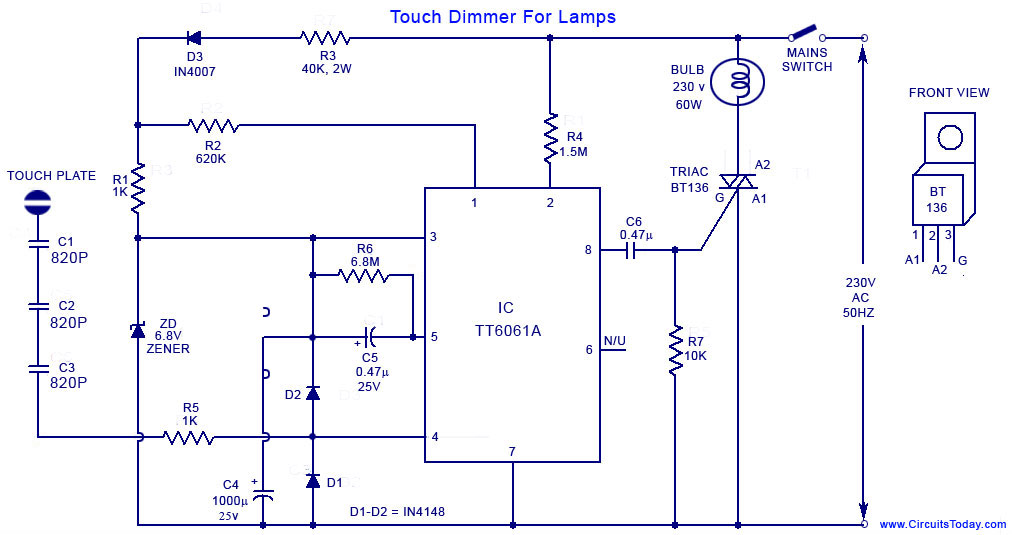This is an interesting project where the intensity of a lamp can be controlled by touch. Most lamps only have an on/off switch. They don’t have any regulators to increase or decrease the intensity of lighting. Having such a built-in feature is available for some expensive lamps. But the same can be achieved without emptying your wallet if you have the know-how of basic electronics. If you have a wall-mounted lamp one easiest way to control its brightness is to use a regulator switch (the ones we use for fans). But if you want to make it more interesting by adding a touch feature check out our project.
Touch Lamp Control Dimmer
This is a simple touch dimmer circuit made of IC TT6061 . TT 6061 is specifically designed for this purpose. By touching this touch dimmer you can increase the light intensity of incandescent lamps in three steps.
At first, when mains is ‘on,’ the lamp is ‘off’. When you touch the plate, the lamp glows dimly. At the second touch, the bulb gives medium light. On the third touch, the bulb is driven fully. Next touch puts off the light.
Line frequency is taken through R4 to pin 2 of IC. At zero crossing the IC fires a pulse to trigger the Triac. The width of this firing pulse depends on the n0: of touches on the plate. Thus by each touch, the firing angle of SCR is varied which in turn varies the brightness of the lamp.
Components R1, R3, D3, ZD, and C4 form the power supply section. Resistors R1 and R3 limit the inrush current. Diode D3 is used for rectification while Zener diode ZD does the job of rectification. C4 is the filter capacitor. Pin 1 and 2 of the system frequency input pin and input frequency input pin respectively. Pin2 is connected to the mains voltage using a 1.5K resistor and pin 1 is connected to the cathode of the rectifier diode using a 620K resistor. R7 is the pull-down resistor for the gate of the TRIAC. Capacitors C1, C2 and C3 are meant for isolation. Never change their value or replace them with a single one. For the touch plate, we can use a 1 square cm metal plate.
If you are interested in light-based circuit applications, try our super bright led night light and also this mains operated led circuit. Most people love to build an emergency light, and if you like to build one here is our automatic led emergency light. If you still need more lighting circuits, visit our category collection of lighting circuit applications.
Caution!
Use exact rating capacitors with the touch plate. Do not touch any other part of the circuit other than the touch plate. Ensure that the touch plate is not live, using a tester before using or testing the circuit. Do not use a bulb with a power rating of more than 200 Watts. Do this circuit under your own risk. I have no responsibility for any mishaps.
Pin Assignments of IC TT6061A.
Pin No. Pin name Function description
1 CK System clock input
2 FI 50Hz line frequency
3 VDD Power input pin for VDD
4 TI Touch input
5 CI Sensor control input
6 NC Not connected
7 VSS Power input pin for VSS
8 AT
Touch Lamp Control Dimmer Circuit Diagram
I hope you enjoyed building this “touch-based dimmer” circuit. This circuit gives you a good idea of handling triacs, IC TT6061, Zener diodes, and other components. This is an easy to build circuit and can be used for the school level or entry-level projects.


4 Comments
Hello,
is it possible to have the effect using 24V operated circuit?
the light controlled will be 24V with dimming.
thanks,
Hi, Good Day..
How can we connect this circuit to a same voltage but of 60 Hz Frequency, any circuit modification to make?
Thanks in advance.
please send me the datasheet of TT6061A IC BECAUSE IT SI AVAILABLE in japanese language.please send me datasheet in english language. I have been waiting for you.
Hi!
Excellent circuit. Is it possible modify the circuit for 120V/60Hz operation?
Thanks
Best regards!